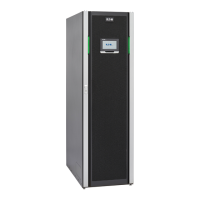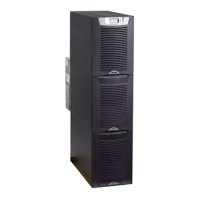Eaton® 9390 (100–160 kVA) UPS Installation and Operation Manual 164201604—Rev F 48
77..33 FFuunnccttiioonnaall DDeessccrriippttiioonn
The UPS is a true online double-conversion unit with a transformerless power train. A high-frequency active
rectifier powers a high-frequency three-phase inverter. The bypass circuit uses a solid-state continuous-duty
static switch. The UPS operates from battery strings from 192 cells (384V) to 240 cells (480V).
77..33..11 IInnppuutt RReeccttiiffiieerr
The rectifier is a three-phase, high-frequency PWM, IGBT-based power conversion stage that provides input
power factor correction and low input current harmonic distortion. The rectifier maintains a DC level that is
optimized for maximum inverter efficiency. A precharge system charges the energy storage elements in the
power train prior to energizing the rectifier.
77..33..22 IInnvveerrtteerr
The inverter is a three-phase, high-frequency PWM, IGBT-based power conversion stage that continuously
supplies the critical load with high-quality AC power. The IGBTs are modulated to maintain the highest
efficiency.
77..33..33 BBaatttteerryy CChhaarrggeerr aanndd AABBMM
The charger is a high-frequency, IGBT-based power conversion stage. The UPS uses ABM technology, which
essentially isolates the battery from the electrical environment, except for periodic charging or reserve mode
operation, extending its life.
ABM extends battery life by keeping the batteries charged and performing periodic battery testing.
An ABM charging cycle starts with the charger driving the battery voltage, at maximum current limit, to a
battery charge level of 2.34 volts/cell. The time it takes for the voltage to reach to the battery charge level is
saved as the battery charge time. If the battery charge time exceeds 100 hours, an alarm sounds.
As soon as a battery charge level of 2.34 volts/cell is reached, the battery is charged at a float level of 2.31
volts/cell for 48 hours (battery float time) plus 150% of battery charge time. Twenty-four hours into the float
period, a series of battery tests are performed to check the battery health. The float level charge continues
after a successful test.
At initial startup, the battery run time on the front panel display indicates two minutes. After the 24-hour float
charging period and battery testing, the actual battery run time is determined and the actual battery run time is
displayed.
After the float period is completed, the charger is disconnected and the batteries are allowed to rest for 672
hours (28 days) maximum rest time. If the battery voltage falls below the opportunity charge level of 2.1 volts/
cell during the first 240 hours of the rest period, an alarm sounds.
An ABM charge cycle is initiated whenever one of these four conditions occurs since the last charge cycle:
• The batteries have rested over the maximum rest time of 672 hours.
• Accumulated discharge time is over a maximum battery discharge time of 20 seconds.
• Battery voltage is under the opportunity charge level of 2.1 volts/cell and the unit has been in rest mode for
longer than 240 hours.
• An XCP command Initiate Battery Test is received.
77..33..44 BByyppaassss
The bypass has a continuous-duty fully-rated SCR switch in the bypass circuit and a contactor in the inverter
leg. In Normal mode, the contactor connects the inverter to the output. A backfeed contactor is also provided.
77..33..55 BBaatttteerriieess
The UPS operates from battery strings from 192 cells (384V nominal) to 240 cells (480V nominal).
Understanding UPS Operation

